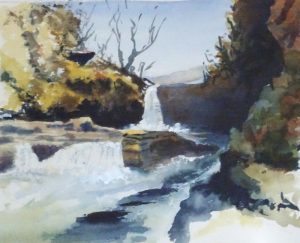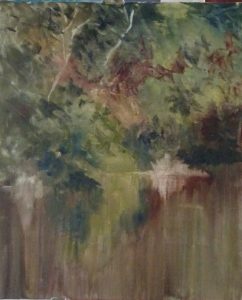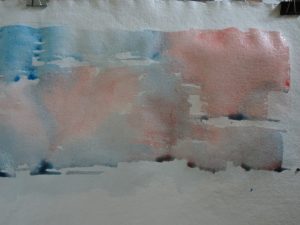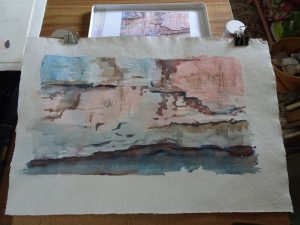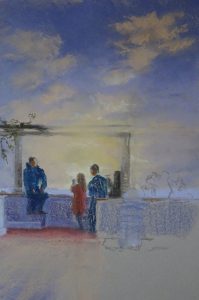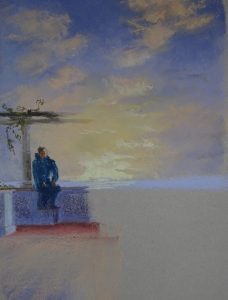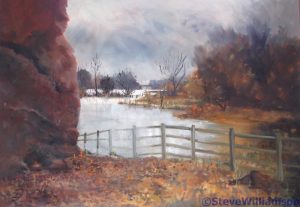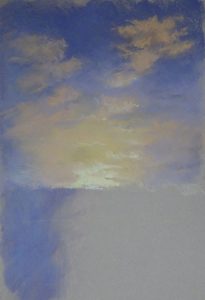This is fun, just the job for a rainy afternoon. It’s a bit of a mash up, derived from the third and final painting in the watercolour class and from a DVD I have by Jean Haines, “Watercolour Passion”. Both tutors were using very wet paint, Mike to create an atmosphere and Jean to loosen the mind and hand/arm in watercolour exercises which might, or might not be useful later.
The image for the course painting was of Milford Sound in New Zealand, with steep slopes and lowering clouds, a bright sea and a small steamer. Mike was mixing his colours on the palette to achieve his vision, but Jean’s use of intense neat colour in the presence of copious amounts of water appealed to the colourist in me.
 I set the board at an acute angle about 45 degrees, and the paper at an angle on the board, as you can see. The intention is to encourage the paint to run diagonally down the paper. Using my squirrel mop, I started in the top corner using neat Indigo,just a few strokes fanning out. Then I loaded the cleaned brush with clean water stroking some at the edge of my paint strokes and some in the dark wet Indigo so that it ran in varying strengths but always diagonally. I had a picture to paint (!) so I stopped the careering paint with a stroke of clean water in the opposite direction defending the dry paper behind it which later had pale colour added. About half way down the paper I needed to make room the sea, so I laid a piece of clean cloth across the paper and mopped up the excess water. I laid damp brush strokes of clean water across the sea horizontally, letting the mountains bleed a bit. I did enjoy that!
I set the board at an acute angle about 45 degrees, and the paper at an angle on the board, as you can see. The intention is to encourage the paint to run diagonally down the paper. Using my squirrel mop, I started in the top corner using neat Indigo,just a few strokes fanning out. Then I loaded the cleaned brush with clean water stroking some at the edge of my paint strokes and some in the dark wet Indigo so that it ran in varying strengths but always diagonally. I had a picture to paint (!) so I stopped the careering paint with a stroke of clean water in the opposite direction defending the dry paper behind it which later had pale colour added. About half way down the paper I needed to make room the sea, so I laid a piece of clean cloth across the paper and mopped up the excess water. I laid damp brush strokes of clean water across the sea horizontally, letting the mountains bleed a bit. I did enjoy that!
Let it dry thoroughly.
 I used Manganese blue for the water, turning the paper to an upright position and using it quite intensely near the mountains, adding water as I approached the bottom of the paper. At this board angle you don’t get cauliflowers! Some dry brush strokes added craggy detail to the mountains. Again let it dry thoroughly. Finally I put in the steamer to give scale to the mountains and give humanity to the painting. Though it’s not a masterpiece, it was exhilarating. I think I prefer stage one to the finished result.
I used Manganese blue for the water, turning the paper to an upright position and using it quite intensely near the mountains, adding water as I approached the bottom of the paper. At this board angle you don’t get cauliflowers! Some dry brush strokes added craggy detail to the mountains. Again let it dry thoroughly. Finally I put in the steamer to give scale to the mountains and give humanity to the painting. Though it’s not a masterpiece, it was exhilarating. I think I prefer stage one to the finished result.

